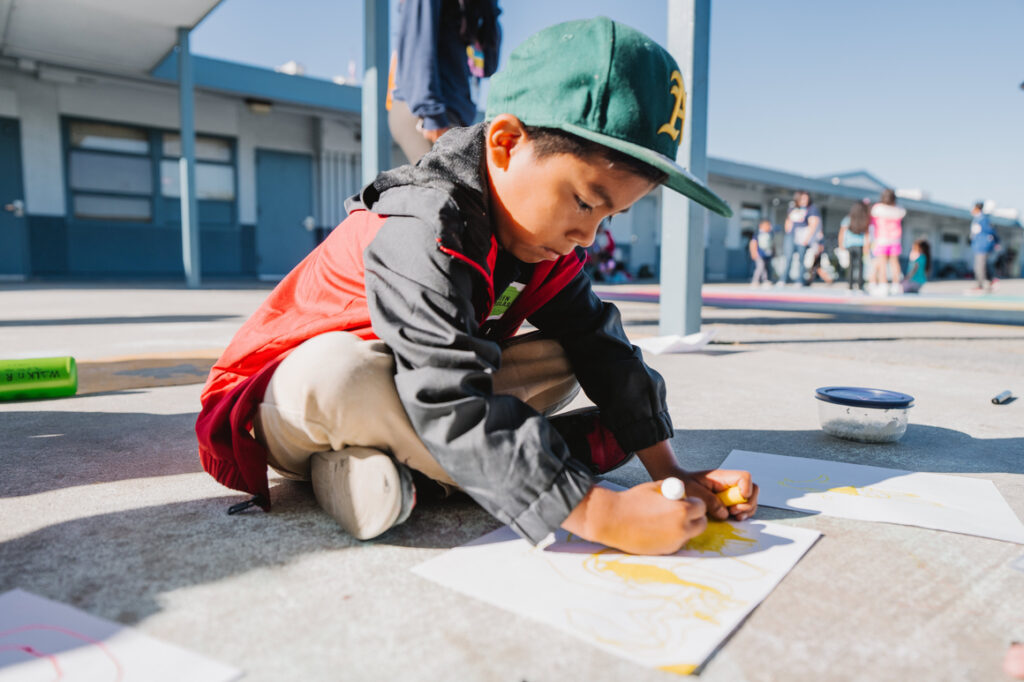Science, Technology, Engineering and Mathematics (STEM) is the backbone of the American education system, and 93% of parents believe it should be a top priority in our schools. STEM education is crucial for developing the skills needed in today’s job market, and starting with fun science activities like the ones described here can ignite a lifelong passion for learning.
Even still, the importance that our society places on STEM isn’t necessarily reflected in our students’ abilities. Case in point: by eighth grade, nearly 60% of American kids have only a basic or below basic proficiency in science- and math-related subjects.
Thankfully, STEM is a fascinating field with a wide variety of exciting topics to explore. Likewise, there are plenty of engaging ways to teach children more about the inner workings of the world around us. One of the best things about these STEM activities is that they use household materials, making them both accessible and affordable. So, grab your lab coat and calculator—in this guide, we’re exploring four STEM activities for middle schoolers to incite their interest in this crucial academic discipline.
Why STEM Activities Matter for Middle Schoolers
STEM—short for Science, Technology, Engineering and Mathematics—is more than just a buzzword in education. These fields teach kids how to ask questions, solve problems and think critically about the world around them. For middle schoolers in particular, hands-on STEM activities help bridge the gap between abstract concepts and real-world applications.
At this age, students are naturally curious and eager to explore. Engaging them in interactive projects not only builds foundational skills in math and science but also fosters creativity, collaboration and perseverance. STEM activities give kids the tools to become tomorrow’s innovators while having a ton of fun today.
Let’s walk through some fun at-home STEM activities for middle schoolers!
1 – The Egg Drop Challenge
Let’s start things off with a classic science activity. The Egg Drop Challenge has been a mainstay of science curriculums for decades, and that’s no fluke—it’s fun, interactive and teaches some of the most essential tenets of physics. These include:
- How the force of gravity causes objects to fall
- Mass and its effect on velocity
- Air resistance, or drag
- Kinetic energy
- Shock absorption
The Egg Drop Challenge has had countless iterations across the world, but its core goal is always the same: use basic materials to prevent an egg from breaking after it’s dropped from a significant height.
It’s up to you to decide what kinds of supplies to give your children, but one common toolkit for taking on this challenge includes:
- Two balloons
- Two small paper cups
- Four straws
- One square foot of cellophane
- Four rubber bands
- Four popsicle sticks
- Two feet of tape
- One egg
Using these materials, kids can craft a variety of contraptions to keep their eggs intact. They could utilize the cellophane and balloons to create a parachute—or, they could combine the paper cups and straws to produce protective padding. The choice is up to them as The Egg Drop Challenge challenges middle schoolers to think creatively about a problem and apply real scientific principles to come up with its solution.
Once they finish their creation, bring it up to a second-story balcony (or higher, if you dare) and let it loose. If the egg survives, they can deem their project a success. If it cracks, they can learn from their mistakes and return to the drawing board to envision a more effective solution.
2 – Homemade Ice Cream
This activity ends with a sweet reward that everyone can enjoy: ice cream!
Ice cream is equal parts cuisine and physical science. Making it in your own home allows you to learn the culinary process and discover the fascinating chemical reactions that take place behind the scenes of this frozen dessert.
To begin, gather:
- One pint-size plastic food storage bag with a tight seal
- One gallon-size plastic food storage bag with a tight seal
- Ice cubes
- Duct tape
- Half a cup of whole milk, half-and-half or a non-dairy milk of your choice
- One tablespoon of sugar
- One-quarter teaspoon of vanilla extract
- One tablespoon of cocoa powder
- Six tablespoons of rock salt or ice cream salt
This recipe makes a single scoop of chocolate vanilla swirl but, if you want to change up the taste, you can add concentrated flavorings such as a sweet syrup of your choosing. You can also double it up if you want to make enough for a couple of servings.
To get things churning:
- Fill the larger bag halfway with ice and sprinkle in your salt. The ice will begin to melt into a below-freezing brine.
- If you want to make chocolate ice cream, add cocoa powder to the mix (optional).
- Add the remaining ingredients to the smaller bag, squeeze the air out and seal it tightly with duct tape to prevent it from spilling.
- Put the smaller bag inside the larger one and seal it tightly.
- Vigorously shake the large bag for five minutes or so until ice cream has formed inside the smaller bag.
- Rinse any salt and ice off the bag of ice cream, carefully unseal it and dig in!
Making your own ice cream offers a variety of benefits that reach beyond the cone. It teaches kids about the effects of temperature on changes in states of matter as your liquid ice cream base quickly turns solid before your eyes.
You can also take the opportunity to talk about the interesting effects of salt on the freezing point of water. Brines don’t actually freeze at 32℉ (0℃) like pure water, and the ten percent (or so) saline solution in your bag really forms ice at 20℉ (-6℃).
After explaining all of this, don’t forget to test out the delicious spoils of your ice cream experiment!
3 – Building a Solar-Powered Oven
Let’s keep exploring the relationship between STEM and the culinary arts but turn the heat up a notch. Instead of making a frozen dessert, this project will have kids cook a snack using the sun as their sole source of power.
This experiment is perfect for those hot summer days when you want to enjoy the weather but also do something constructive and informative with your kids. To get the griddle sizzling, assemble:
- A cardboard pizza box or another box of similar size
- Black duct tape
- Aluminum foil
- Packing tape or glue
- Scissors
- Wooden skewers, chopsticks or similarly long, thin objects
- Food to heat up—such as cheese on toast, marshmallows and chocolate for smores or other quick-melting items
If the weather’s not cooperating in your area, you can always substitute a desk lamp or two to simulate the sun—though the experiment may take a bit longer. To construct your oven:
- Line the bottom of the box’s interior with black duct tape.
- Tape or glue aluminum foil over the rest of the box’s interior.
- Place your food inside the oven.
- Use your skewers or chopsticks to prop the box’s lid up at an angle that allows maximum sunlight to hit the inside.
- Let it sit in the sun for half an hour or more before returning to your melty, warm treat.
- Dig in!
Creating their own solar oven allows kids to explore some fundamental principles of modern science. For starters, it demonstrates how we can harness the power of the sun for our own purposes, such as heat or solar energy. It also affords you the opportunity to touch on renewability and explain how, unlike other energy sources, power from the sun is limitless and doesn’t pollute the environment.
This experiment also presents the perfect chance to demonstrate the effects of reflecting and concentrating light. Describe how the sun’s rays intensify as the aluminum foil focuses them on a singular spot. Then, explain that the tape below retains the oven’s heat since black absorbs the most potential light and energy from the sun.
Just like the ice cream, don’t forget to enjoy the results of your hard work once they’re nice and gooey!
4 – The Decimal Pairing Game
By the time they reach middle school, many students have already studied decimals and will have a working idea of how to use them in math problems. The Decimal Pairing Game invites them to test these skills as they find matching decimals that add up to a predetermined whole number. It requires a decent-sized group to play, so it’s best done in a classroom or among your child’s squad of close friends.
For supplies, you’ll only need:
- Some scraps of paper
- A writing utensil
To begin, pick a whole number that your kids will aspire to make. Then, write corresponding decimals that add up to that number on different scraps of paper.
Ten is a popular choice as it’s a fairly simple, round number. In this case, you may write decimal pairs such as 7.4 and 2.6, 4.3 and 5.7 and so on. If your kids are already familiar with fractions, try using larger, odd numbers such as 23. If you really want to amplify the difficulty, you can even use a decimal as the final number they try to make.
After writing your decimal pairs, mix them up and distribute them amongst your group. Then, have the kids look around for their corresponding piece of paper. Encourage them to work out the answer in their head before seeking their matching decimal—instead of having players ask “What’s your number?” have them ask, “Do you have X number?”
This engaging activity not only helps students work on their addition skills and understand decimals better but also encourages them to collaborate and agree on answers. It’s perfect for reviewing how decimals work while still keeping kids on their toes and active.
5 – DIY Weather Station
Let’s take STEM outdoors with an activity that blends environmental science, data collection and engineering: building your own weather station. Middle schoolers will love playing the role of meteorologist as they track real-time weather patterns using simple homemade instruments.
A DIY weather station introduces kids to atmospheric science while encouraging observation, measurement and analysis—key elements of the scientific method.
To set up a basic weather station, you’ll need:
- One clear plastic bottle (for a rain gauge)
- A ruler and permanent marker
- Scissors
- Tape
- A plastic straw
- A cup with a lid (for a wind vane base)
- A pencil with an eraser
- Cardstock or heavy paper (for the wind vane arrow)
- Compass or smartphone (for cardinal directions)
- Thermometer (store-bought or DIY version)
To create the rain gauge:
- Cut the top third off the plastic bottle and invert it inside the base like a funnel.
- Use the ruler and marker to add measurement lines in centimeters or inches on the side.
- Tape the bottle to a flat surface outside and check rainfall daily.
To create the wind vane:
- Cut an arrow shape from cardstock and tape it to the straw.
- Push the straw through the eraser of the pencil so it spins freely.
- Place the pencil into the cup and secure it upright with clay or sand.
- Use a compass to label the cardinal directions (N, S, E, W) around the vane.
Optional Add-ons:
- Barometer: Use a balloon stretched over a jar to measure air pressure changes.
- Hygrometer: Measure humidity with a strand of human hair and a pointer dial (or a more basic version using sponge weight change).
Once your weather station is set up, have students record daily data in a weather journal. They can track patterns, make forecasts and even compare their readings to local weather reports.
This activity doesn’t just teach kids about meteorology—it also builds skills in data collection, critical thinking and scientific communication. Bonus: it may just spark a lifelong interest in climate science!
Enroll Your Child at Camp Galileo to Refine Their STEM Skills
Exploring the different facets of the STEM field, such as technology, engineering and mathematics, allows students to discover which areas they are most passionate about. STEM for middle schoolers is a crucial discipline to explore and develop. Interactive activities like the ones above help give kids a sense of the field and its essentials—but a fun, engaging summer program at Camp Galileo can really broaden their STEM perspectives.
The creative itinerary at Camp Galileo takes STEM exploration a step further by encouraging kids to discover STEAM (Science, Technology, Engineering, Arts and Mathematics) principles. This collaborative, play-based foray into science, art and design inspires middle schoolers to become confident, resilient, out-of-the-box thinkers who strive to make the world a better place. Our program also emphasizes engagement and excitement in all our experiences to create a truly unforgettable, transformative camp itinerary.
Explore our summer camps in California, Colorado, Chicagoland, and Seattle! Located in Northern California? Be sure to check out our SF, Berkeley, Oakland and Marin County summer camps! We have Camp Galileo locations across many communities. Explore our Camp Finder to find the location nearest you!
Find a location near you, and enroll your child at Camp Galileo for a summer of STEM, art and fun!
Sources:
- Microsoft. STEM Perceptions: Student & Parent Study. https://news.microsoft.com/
- National Science Foundation. How proficient are U.S. 8th graders in math and science?. https://www.nsf.gov/.
- Virginia Tech. Egg Drop Project. https://www.phys.vt.edu/.
- Orlando Science Center. Ice Cream Science Project: How to Make Ice Cream in 3 Simple Steps. https://www.osc.org/.
- Imperial College London. Solar oven – activity. https://www.imperial.ac.uk/.
- Math Teacher Coach. 13 Fun and Educational Math Activities for Middle School. https://mathteachercoach.com/.



